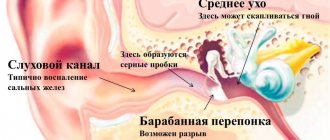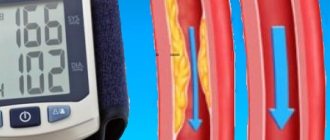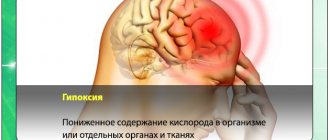- What is high or low intracranial pressure?
- How to check intracranial pressure
- What is the danger of intracranial hypertension or hypotension?
- Where can I get an MRI of the brain?
Headache, spots before the eyes, vomiting, blurry silhouettes around and the ground disappearing somewhere from under your feet - all these alarming symptoms may indicate increased intracranial pressure. But if blood pressure can be measured independently with a tonometer in just a couple of minutes and reduced with the help of one vasodilator pill, then with intracranial hypertension everything is much more complicated. Only with the advent of MRI of the brain did it become possible to carry out non-invasive diagnostics and find the cause.
Intracranial hypertension clinic
The time during which the pressure rises characterizes the severity of complaints and symptoms.
Main complaints of intracranial hypertension:
- constantly intensifying long-term headache, which is perceived as pressing, is located in the temples, intensifies with physical activity, reaching a maximum in a horizontal position, after a night's sleep;
- nausea, vomiting. More often in the morning, sometimes without previous nausea;
- hiccups;
- double vision;
- changes in vision that occur when the head position changes;
- drowsiness;
- disturbance of consciousness;
- breathing disorder.
Ten causes of intracranial hypertension:
- Tumor of the brain or spinal cord;
- Benign hypertension;
- Hydrocephalus;
- Stroke;
- Meningitis;
- Traumatic brain injury;
- Encephalopathy due to high blood pressure;
- Brain swelling;
- Severe heart failure;
- Obstructive pulmonary disease.
Life-threatening complications of intracranial hypertension:
- compression of the brain;
- extrusion of the brain from one part of the skull to another (herniation)
What is high or low intracranial pressure?
The skull forms the skeleton of the head. Its brain part resembles a hemisphere, and together with the facial part, the skull vaguely resembles a ball. The brain with cerebrospinal fluid is located inside strong curved bone plates - in the upper part of the cranial cavity. But the brain with cerebrospinal fluid is not isolated in some kind of sealed “vessel”. CSF and blood constantly circulate, providing constant intracranial pressure.
Normally, the pressure inside the skull ranges from 7.5-15 mm Hg. But sometimes a malfunction occurs in this well-functioning system - the proportional ratio of brain tissue and the total volume of all fluids is disrupted. If the deviation is insignificant, then the body independently “launches” a compensatory mechanism. But if there is some serious pathology and there are not enough internal resources, then intracranial pressure increases. Roughly speaking, more tissue and fluid accumulate in the cavity than can fit there. An uneven increase in pressure in different structures is especially dangerous. The opposite situation is no less alarming, when the pressure inside the skull decreases. But don’t panic right away - our site will tell you why this situation may arise, how to check intracranial pressure and where to get an inexpensive MRI of the head.
Read also
Neurogenic bladder
In a healthy person, the process of urination is carried out in the form of a voluntary reflex act, and we can control it.
However, this is not the case with this disease. Patients are extremely... Read more
Encopresis
Encopresis is a condition in which a person does not control or feel the urge to defecate, and also cannot control the act of defecation itself; Fecal incontinence significantly impairs the patient’s quality of life,...
More details
Weakness and numbness in the arm and leg
The appearance of general muscle weakness and numbness in the body, arm or leg is a very serious syndrome, and if it occurs, you should consult a neurologist as soon as possible. Connected…
More details
Chiari malformation
What is Chiari Malformation? Chiari malformation (formerly Arnold-Chiari malformation) is a congenital defect of brain development that involves the dislocation of the cerebellar tonsils into the spinal canal through the large…
More details
Facial paralysis (Bell's palsy/facial neuritis)
Facial paralysis is spontaneous weakness of ½ of the face. The cause is swelling of the facial nerve, as a result of its compression inside the temporal bone or in the outlet from it. Most often this leads to...
More details
How to check intracranial pressure
Since the pressure is created inside the skull, it is impossible to measure it using household methods. Previously, they either did a spinal puncture and used it to roughly estimate the pressure inside the skull, or they opened the skull and measured the pressure directly in the ventricles of the brain or in the epidural space with strain gauges. But now it is possible, without such traumatic experiments, to very accurately determine the pressure value, to identify the occurrence of gradients and the localization of areas with elevated values, and to establish the cause of the pathology. To do this, an MRI of the head and brain is prescribed - a painless and safe diagnostic procedure.
Is it worth getting an MRI if you have high blood pressure?
The answer to this question depends on whether the patient has indications and contraindications for this procedure. Thus, in some cases, MRI at high blood pressure makes it possible to timely detect various diseases in their initial stages.
Indications
The exact indication for the study is symptomatic hypertension, when high blood pressure is a symptom of serious diseases: pyelonephritis, hydronephrosis, renal artery stenosis, tuberculosis, as well as the presence of benign and malignant tumors.
Contraindications
All contraindications are divided into absolute and relative. Even with high blood pressure, MRI is prohibited for patients who have pacemakers or other electronic devices that ensure normal functioning. The procedure is contraindicated for pregnant women - during the entire first trimester. You should also refrain from it if there are metal fragments in the body (near the neurovascular bundles). The procedure is not performed on patients with claustrophobia.
As for relative contraindications, these include the presence of an intrauterine device in women, as well as various non-ferrimagnetic structures. Whether it is possible to do an MRI with high blood pressure in these cases depends only on the patient himself, his subjective feelings, the design of the tomograph and the availability of recommendations from the attending physician.
MRI of the brain on an open tomograph
Diagnostic centers can be equipped with open and closed type tomographs. Closed devices are installations in the form of a cylindrical tube, where the patient’s body is placed during the scan. Open tomographs are a structure where the magnet is located in the form of a canopy.
This design allows examinations to be carried out in comfortable conditions, even for patients with a fear of confined spaces. For confidence and greater comfort, the examinee can invite a loved one to stay with him. Parents can be with the child during the scanning session. If, however, any circumstances arise that prevent the patient from continuing the study, the MRI machine is equipped with a call button that allows you to give an audible signal to the staff. In this case, the diagnosis will be suspended, and a doctor will approach the patient, who will find out and eliminate the causes of concern.
| OPEN TYPE MRI | SEMI-OPEN MRI | CLOSED MRI |
Preparing for an MRI
Usually the examination takes place without special preparation. In some cases, by decision of the doctor, the specialist may ask you to abstain from food or any drinks (coffee, tea) in the morning . Already in the laboratory, before the procedure itself, it is necessary to remove all gold or silver jewelry, otherwise they will interfere with the magnetic fields from doing their job.
You may also need to change to a special surgical shirt. The need for this is determined by how many metal parts there are on the clothing and how spacious it is.
Female representatives must inform their doctor about their pregnancy, even at the earliest stage. Until now, there has not been a single case where MRI has negatively affected the body of the mother or the unborn child, but doctors are not 100% confident in the complete safety of the study.
First, the radiologist must review the patient’s medical history, operations and find out whether the patient has artificially implanted implants.
CT scan of the skull with 3D effect
Despite the fact that CT requires the use of ionizing radiation, it is also often used because it is effective for examining the facial skeleton. What brought him to the level of MRI was the ability to create a three-dimensional image (3D).
Compared with magnetic tomography, computed tomography can more thoroughly and in detail evaluate bone pathologies of the skull in the cranio-orbital and craniobasal region. Three-dimensional reconstruction allows the treating specialist to examine the facial skeleton in volume and model the necessary implants for it with suitable sizes.
The full name of this procedure is “multislice computed tomography with 3D reconstruction” (MSCT).
MRI for hypertension
Hypertension, or hypertension, or in other words, high blood pressure, is observed in a huge number of people on the Earth, and older people are especially susceptible to this disease. A surge in pressure never goes away without leaving a trace: the heart rate may increase, the head may become dizzy, nausea and even vomiting may appear, and in some cases the person loses consciousness.
If you periodically suffer from high blood pressure, then the first thing you should do is visit a doctor: in addition to tests and ultrasound, the specialist will definitely prescribe an MRI, which will show what treatment tactics need to be applied.
When is it necessary to undergo an MRI?
The sooner the doctor refers you to the procedure, the better it will be, especially in cases where pressure surges are already regular. If symptomatic hypertension is suspected, delay is not acceptable at all, as it can significantly worsen the current situation.
Causes of high blood pressure
Hypertension can appear seemingly out of nowhere. However, if you dig deeper, you can always find the reason that made you feel not the best. This can be constant stress experienced both at work and at home, chronic fatigue, regular lack of sleep. All these minor factors greatly influence cellular nutrition. As a result, the flow of oxygen decreases, blood pressure increases - the body seems to be trying to cope with the existing problem.
Cranial nerves
Magnetic resonance imaging of the skull also reveals pathology of the cranial nerves. Most often, an accurate diagnosis of neurovascular conflict is performed at the site where the nerve exits the trunk. Other pathologies leading to hemifacial spasm are also identified.
External symptoms for which the examination is performed are spasms of the facial muscles with tonic and clonic contractions.
To study cranial nerves, a specific pulse sequence is used and slice blocks are laid depending on which cranial nerve is being studied:
- to obtain a clear image of the olfactory nerve (bulb and tract), a block of slices is used in the axial plane, parallel to the course of the nerve itself;
- optic nerve - MRI makes it possible to examine the nerve itself, its chiasm, and tract;
- to visualize the oculomotor nerve, a block of slices is made, which is oriented in the coronal and sagittal plane;
- the trochlear nerve is visualized as a block of slices with one landmark - the inferior colliculus of the midbrain;
- the ternary nerve is examined by a block of sections in the region of the root of this nerve, with a guide to the location of its trunk in the lateral cisterns of the bridge, and is also examined in the sagittal, axial and coronal planes;
- The vestibulocochlear nerve is examined using a block of sections in the lower surface of the brain outside the olive of the medulla oblongata.
Consequences of cranial MRI examination
Patients usually tolerate this procedure without pain or consequences. But there are some exceptions. During the examination, the patient may feel discomfort. It has to do with immobility. There are manifestations of attacks of claustrophobia even in trained people. In this case, the patient needs to take a sedative.
Additionally, the temperature of the head may increase, which is considered normal.
When using contrast material, you may feel a rush of blood and coolness, this is also considered normal. The process of inserting and removing the catheter may cause some discomfort and may cause irritation. Pain or nausea may occur. Due to the use of contrast agents after the examination, intracranial pressure or ocular itching may occur.








